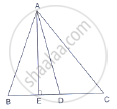Advertisements
Advertisements
Question
The co-ordinates of the points A, B and C are (6, 3), (−3, 5) and (4, −2) respectively. P(x, y) is any point in the plane. Show that \[\frac{ar\left( ∆ PBC \right)}{ar\left( ∆ ABC \right)} = \left| \frac{x + y - 2}{7} \right|\]
Solution
We know that the area of a triangle having vertices (x1, y1), (x2, y2) and (x3, y3) is\[\frac{1}{2}\left| x_1 \left( y_2 - y_3 \right) + x_2 \left( y_3 - y_1 \right) + x_3 \left( y_1 - y_2 \right) \right|\]
Area of ∆PBC
\[ = \frac{1}{2}\left| 7x + 7y - 14 \right|\]
\[ = \frac{7}{2}\left| x + y - 2 \right| \text{square units}\]
\[ = \frac{1}{2}\left| 42 + 15 - 8 \right|\]
\[ = \frac{49}{2} \text{square units}\]
\[ \Rightarrow \frac{ar\left( ∆ PBC \right)}{ar\left( ∆ ABC \right)} = \frac{\left| x + y - 2 \right|}{7} = \left| \frac{x + y - 2}{7} \right|\]
APPEARS IN
RELATED QUESTIONS
Using Pythagoras theorem determine the length of AD in terms of b and c shown in Figure.
ABCD is a square. F is the mid-point of AB. BE is one third of BC. If the area of ΔFBE = 108 cm2, find the length of AC.
Each side of a rhombus is 10 cm. If one of its diagonals is 16 cm find the length of the other diagonal.
In Figure, D is the mid-point of side BC and AE ⊥ BC. If BC = a, AC = b, AB = c, ED
= x, AD = p and AE = h, prove that:
(i) `b^2 = p^2 + ax + a^2/4`
(ii) `c^2 = p^2 - ax + a^2/4`
(iii) `b^2 + c^2 = 2p^2 + a^2/2`

In ∆ABC, ∠A is obtuse, PB ⊥ AC and QC ⊥ AB. Prove that:
(i) AB ✕ AQ = AC ✕ AP
(ii) BC2 = (AC ✕ CP + AB ✕ BQ)
In a quadrilateral ABCD, ∠B = 90°, AD2 = AB2 + BC2 + CD2, prove that ∠ACD = 90°.
∆ABD is a right triangle right-angled at A and AC ⊥ BD. Show that
(i) AB2 = BC x BD
(ii) AC2 = BC x DC
(iii) AD2 = BD x CD
(iv) `"AB"^2/"AC"^2="BD"/"DC"`
State Pythagoras theorem
Find the length of each side of a rhombus whose diagonals are 24cm and 10cm long.
A man goes 12m due south and then 35m due west. How far is he from the starting point.
